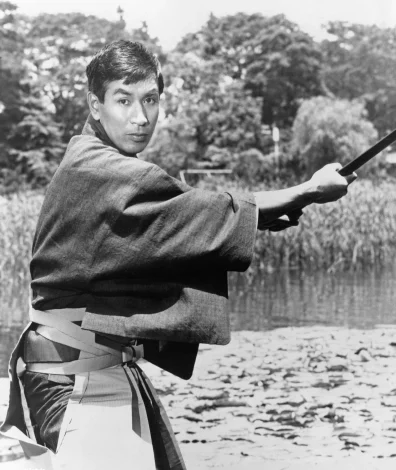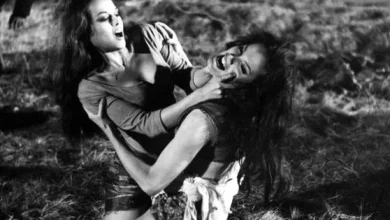James Bond: Warped Ninja History for All Time
Unraveling the Ninja Legend: How Did It Spread Across the Globe?

The legend of the ninja, with its enigmatic warriors skilled in espionage and combat, has captivated the collective imagination of people around the world. From its origins in 19th-century Japan to its widespread popularity in the West, the ninja legend has taken on a life of its own, transcending cultural boundaries and leaving an indelible mark on popular culture. This article aims to delve into the intriguing journey of the ninja legend, exploring its historical roots, examining its popularization, and shedding light on the myths and controversies that surround it.
Through an exploration of the prints that emerged in 19th-century Japan, depicting dark-robed figures engaged in stealthy activities, we begin to understand the origins of the ninja legend. However, it was in the aftermath of the Second World War, and notably with the influence of James Bond films like “You Only Live Twice,” that the ninja legend found its way into the Western consciousness. Despite the inaccuracies in these portrayals, they played a pivotal role in popularizing the concept of ninjas among audiences far beyond martial arts enthusiasts.
Key Takeaways:
- The ninja legend emerged in 19th-century Japan through prints depicting stealthy figures. However, its widespread popularity in the West came about after the Second World War, influenced by James Bond movies like “You Only Live Twice.”
- The ninja legend has been embellished and fictionalized in popular media, leading to misconceptions and myths surrounding the true nature of ninjas.
- While there is ongoing debate regarding authenticity, the martial arts community associated with ninjitsu maintains its own distinct traditions and practices.
- Surviving historical artifacts and documents specifically validating the existence of ninjas remain largely elusive, giving rise to skepticism.
- The enduring appeal of the ninja legend has permeated popular culture, influencing various forms of entertainment beyond movies and literature.
How did the ninja legend spread around the world?
The captivating allure of the ninja legend has transcended time and geographical boundaries, captivating the imaginations of people around the world. This article delves into the intriguing journey of the ninja legend, tracing its origins, examining its popularization, and shedding light on the controversies that surround it.
The Emergence of Ninja in Japan and the West
The ninja legend truly began to take on a life of its own during the 19th century in Japan. It was during this period that prints depicting enigmatic, dark-robed figures stealthily traversing castle walls became increasingly prevalent. These artistic portrayals set the foundation for the myths and mysteries that would eventually become intertwined with the concept of the ninja.
However, it was not until after the Second World War that the ninja legend gained significant traction in the West. Surprisingly, the catalyst for its popularity was none other than the iconic fictional character, James Bond. The release of the Bond movie “You Only Live Twice” in the 1960s played a pivotal role in introducing the notion of ninjas to a wider audience, extending beyond martial arts enthusiasts. Curiously, although the film did not portray the ninjas accurately, instead depicting them as commandos, it sparked a surge of interest in the West.
Separating Fact from Fiction
The widespread dissemination of ninja-related information, particularly on the internet and in books, has given rise to a plethora of misconceptions and myths. Countless titles promising insights into the “art of invisibility” or techniques on “how to disappear” have been crafted since 1945 to cater to a burgeoning ninja community. These works often lack historical accuracy and instead emphasize the mystical aspects associated with ninjas.
One notable aspect of the ninja legend is the ongoing debate among practitioners about what constitutes true ninja-ism and authenticity. Some individuals claim to possess ancient scrolls handed down through generations, granting them legitimacy. However, the existence and veracity of these scrolls remain largely unsubstantiated, leaving room for skepticism.
Authenticity and the Martial Arts Community
Despite the blurred lines between fact and fiction, it is important to recognize the separate existence of the martial arts community that revolves around ninjitsu. While the ninja legend may have taken on a life of its own in popular culture, practitioners of this martial art strive to uphold its traditions and techniques.
Within the martial arts community, efforts are made to maintain authenticity and preserve the historical core of ninjitsu. However, it should be noted that the historical documentation and evidence pertaining to the true practices of ninjas are limited. This has led to ongoing discussions and disagreements among practitioners regarding the most authentic representation of ninjitsu.
Exploring the Enduring Legacy
The allure of the ninja legend continues to captivate people worldwide, transcending cultural and generational boundaries. From the captivating prints of the 19th century to its Hollywood portrayal, the ninja legend has undoubtedly left an indelible mark on popular culture.
To delve deeper into the fascinating world of ninjas, one can explore various resources such as reputable books, documentaries, and dedicated websites. Although it is essential to approach these sources critically, they provide valuable insights into the historical context and cultural significance surrounding ninjas.
In conclusion, the journey of the ninja legend from its origins in 19th-century Japan to its widespread popularity in the West is a testament to its enduring appeal. While the myths and misconceptions surrounding ninjas persist, the fascination with their mysterious world continues to captivate enthusiasts and ignite curiosity worldwide.
FAQ: Unraveling the Ninja Legend
1. What were the key factors that contributed to the spread of the ninja legend beyond Japan?
The dissemination of the ninja legend beyond Japan can be attributed to a combination of cultural influences and popular media. While the 19th-century prints laid the groundwork, it was the global reach of films and literature that truly propelled the ninja legend into the international spotlight. Through James Bond movies like “You Only Live Twice” and various works of fiction, the enigmatic and stealthy ninja captured the imagination of audiences worldwide, creating a lasting fascination that continues to this day.
2. Were ninjas only portrayed as stealthy assassins, or did they possess other skills and roles?
Contrary to popular belief, ninjas were not solely restricted to the realm of assassins. In addition to their skills in espionage, infiltration, and sabotage, ninjas often fulfilled multifaceted roles. They were adept at gathering intelligence, engaging in guerrilla warfare, and employing a range of unconventional tactics. Their expertise extended beyond combat, encompassing a diverse skill set that included survival techniques, medicine, disguise, and the art of blending into different social contexts. The versatility of ninjas allowed them to adapt to various situations, making them invaluable assets in feudal Japan.
3. How accurate are the popular depictions of ninjas in movies and literature?
Popular depictions of ninjas in movies and literature often embellish their abilities and exploit their mystique for dramatic effect. While these portrayals may be entertaining, they frequently deviate from historical reality. Ninjas were not supernatural beings with the ability to disappear at will; instead, they relied on their meticulous training, cunning strategies, and knowledge of their surroundings to achieve their objectives. It is important to approach these portrayals with a critical eye, appreciating them as creative interpretations rather than accurate representations of historical ninjas.
4. Did the ninja legend have any impact on real-life martial arts practices?
Yes, the ninja legend undeniably influenced real-life martial arts practices. While the authenticity and historical accuracy of contemporary ninjitsu are subjects of debate, the concept of ninjas and their unique skill set has had a significant impact on various martial arts disciplines. Many martial artists have been inspired by the agility, adaptability, and unconventional techniques associated with ninjas. As a result, elements of ninjitsu have been incorporated into different martial arts styles, enriching their repertoire of techniques and strategies.
5. Are there any surviving historical artifacts or documents that authenticate the existence of ninjas?
The existence of surviving historical artifacts or documents specifically authenticating the practices of ninjas remains elusive. While there are claims of ancient scrolls and lineage that can be traced back to the Middle Ages, their actual existence and validity are subjects of controversy. The lack of concrete evidence has fueled skepticism among historians and scholars. As of now, the true nature of these artifacts and their direct connection to historical ninjas remains largely unproven.
6. How has the ninja legend influenced popular culture outside of Japan?
The impact of the ninja legend on popular culture outside of Japan is undeniable. Beyond movies and literature, ninjas have permeated various forms of entertainment, including video games, comics, and animated series. Their iconic image and mystique continue to captivate audiences, inspiring countless adaptations and references across different mediums. The enduring popularity of the ninja legend serves as a testament to its universal appeal and its ability to transcend cultural boundaries.
7. Are there any real-life modern practitioners who follow the ways of the ninja?
Yes, there are modern practitioners who study and practice the arts associated with ninjas, albeit with varying interpretations and emphasis on historical accuracy. These individuals often engage in disciplines such as ninjitsu or other martial arts influenced by the ninja legend. While some claim to possess authentic knowledge passed down through generations, it is important to approach such claims with critical scrutiny and seek reputable sources for accurate information on the subject.
8. How has the perception of ninjas evolved over time?
The perception of ninjas has undergone a significant transformation over time. From being covert operatives in feudal Japan, the image of ninjas has been romanticized and exaggerated in popular culture. They have transitioned from being primarily associated with assassination to embodying a broader range of skills and abilities. The evolving perception of ninjas reflects the enduring fascination with their mystique and the desire to explore their multifaceted nature beyond historical records.
9. What role did the internet play in the spread of the ninja legend?
The internet has played a pivotal role in the dissemination and perpetuation of the ninja legend. With the advent of the digital age, information on ninjas became readily accessible to a global audience. Websites, forums, and online communities dedicated to the subject emerged, fostering discussions, debates, and the sharing of knowledge. While the internet has provided a platform for the exchange of information, it has also contributed to the proliferation of misinformation and fictionalized narratives surrounding ninjas.
10. How can one separate fact from fiction when researching the history of ninjas?
When researching the history of ninjas, it is crucial to approach the subject with a critical mindset and seek reliable sources of information. Academic publications, reputable historical accounts, and works authored by recognized experts in the field are valuable resources for separating fact from fiction. It is also important to cross-reference multiple sources and be mindful of biases or sensationalized claims. By employing rigorous research methodologies and consulting credible authorities, one can gain a deeper understanding of the historical realities surrounding ninjas.
Conclusion:
The ninja legend, with its aura of mystery and exceptional skills, continues to capture the imagination of people worldwide. Although the myths and misconceptions surrounding ninjas persist, it is essential to recognize the separate existence of the martial arts community dedicated to ninjitsu. While the authenticity of historical artifacts and documents remains a subject of debate, the enduring popularity of the ninja legend serves as a testament to its universal appeal and its ability to transcend cultural boundaries.
By delving into the historical roots, examining the impact of popular media, and acknowledging the ongoing discussions within the martial arts community, we gain a deeper understanding of the ninja legend’s evolution and enduring legacy. As we navigate the complex web of fact and fiction surrounding ninjas, it is crucial to approach the subject critically, relying on reliable sources and expert insights to separate reality from the romanticized allure that continues to captivate us all.









